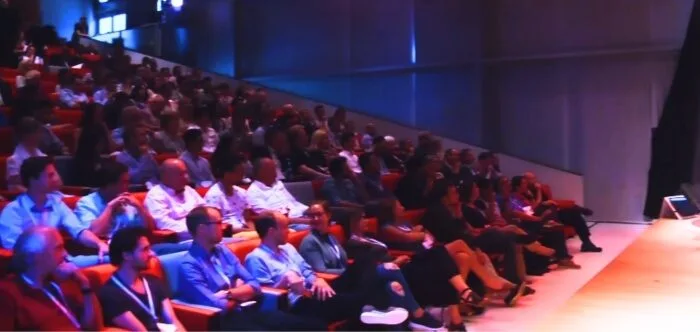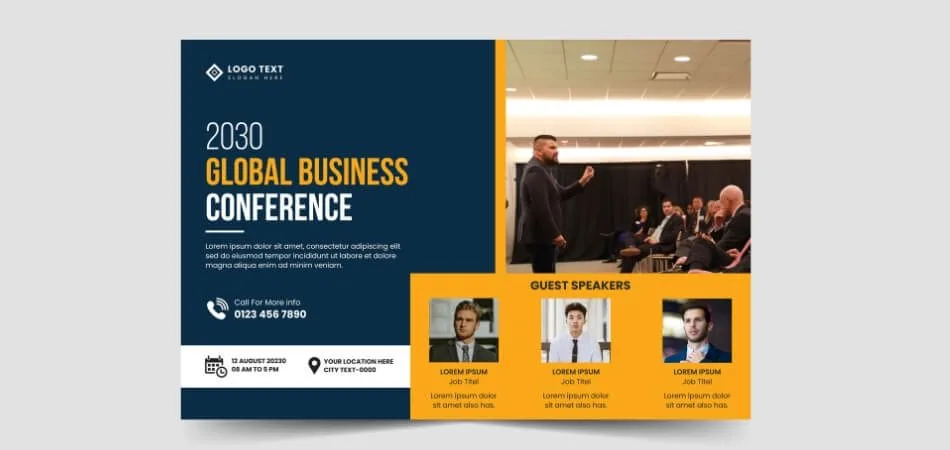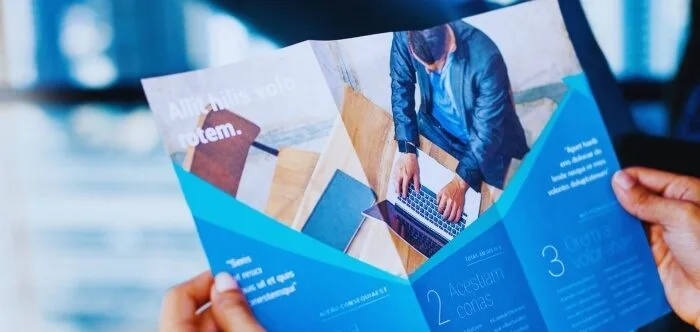Attending a conference is an exciting opportunity, but how do you know what to expect? That’s where the brochure comes in. If you’re wondering what is a conference brochure, it’s the key tool that provides a detailed overview of what to expect at the conference.
A conference brochure typically contains information about the agenda, keynote speakers, session details, and even networking opportunities. It helps attendees to get around the event smoothly and plan their schedule to make the most of their time.
Would you like to know more about how this small booklet can make a big difference in your conference experience? Continue reading to discover the essential role of a conference brochure.
Importance of a Conference Brochure
A conference brochure is important for organizers and attendees, serving multiple functions that enhance the overall event experience. The brochure includes details of the conference schedule, including session times, speaker information, workshops, networking events, and breaks, helping attendees plan their day efficiently. There’s more to the concept of a conference brochure that significantly increases the chances of a successful conference.

- A conference brochure helps attendees identify sessions, workshops, or events most relevant to their interests or professional goals. It features a quick reference guide throughout the conference, reducing confusion and enhancing the attendee experience.
- Showcases key speakers, panel discussions, and highlights from the conference, encouraging attendees to participate actively.
- It provides visibility to sponsors and partners through ads, logos, and dedicated pages, enhancing brand recognition and value. Also encourages attendees to engage through social media, surveys, or app downloads, fostering a more interactive event environment.
- Attendees can use the brochure as a resource after the event, revisiting information on speakers, sponsors, and session content.
- A conference brochure includes important safety information, emergency contacts, and procedures, contributing to a safe and secure event environment.
What is a Conference Brochure?
A conference brochure is a promotional tool in the world of professional events, serving as a bridge between organizers and attendees. It acts as a comprehensive guide, offering a snapshot of what participants can expect from the event. Rich in detail, it outlines the conference’s schedule, key speakers, and various topics to be discussed.

This brochure is more than just an informative piece; it’s a marketing asset that captivates and informs potential attendees. Its design and content are tailored to spark interest and encourage participation. Moreover, it provides practical information, like venue details and registration processes, ensuring attendees are well-prepared.
The importance of a well-crafted conference brochure cannot be overstated in ensuring the success of an event. It’s a reflection of the conference’s quality and professionalism, setting the tone for the entire event. Ultimately, this brochure is an indispensable part of the conference experience, guiding attendees through every step of their journey.
Different Types of Conference Brochures
At any conference, brochures are more than just paper; they’re a gateway to knowledge and engagement. Each type serves a unique purpose, catering to different aspects of the event. Let’s explore the variety of brochures you might encounter at a conference, each with its distinct role and design.
Event Schedule Brochures
These brochures are the attendees’ timekeepers, detailing the event’s chronological flow. They list session times, breaks, and networking events, ensuring no one misses a beat. Color coding or icons often aid in navigating through different tracks or themes. This type is essential for time management and planning one’s day at the conference.
Speaker Information Brochures
Focusing on the personalities driving the event, these brochures introduce the speakers. They include bios, credentials, and topics, providing a background on the experts. These brochures often contain photos and quotes, making the content more engaging. They help attendees decide which talks to attend based on speaker expertise.
Workshop and Session Guides
These are deep dives into specific sessions or workshops offered. They detail topics, objectives, and what attendees can expect to learn. Often, they include information about required materials or prerequisites. These guides are vital for attendees interested in specific learning outcomes or skills.
Sponsor and Exhibitor Brochures
These highlight the businesses and organizations supporting the conference. They provide background information on each sponsor or exhibitor, including their role and offerings. These brochures often include booth locations, making it easier for attendees to find them. They’re great for networking and understanding the commercial backdrop of the event.
Venue and Facility Guides
Crucial for first-time visitors, these brochures map out the venue. They include locations of key areas like session halls, restrooms, and dining options. Accessibility information is often included, catering to diverse attendee needs. They ensure a comfortable and hassle-free experience for everyone.
Feedback and Evaluation Forms
While not traditional brochures, they’re vital for post-event engagement. They ask for attendees’ opinions on various aspects of the conference. This feedback is crucial for organizers to improve future events. These forms demonstrate a commitment to growth and attendee satisfaction.
Brochures at conferences are diverse, each serving a specific purpose. From guiding attendees, through the event to providing valuable insights about speakers and sponsors, these brochures enrich the conference experience significantly.
What are the Components of a Conference Brochure?
A conference brochure is a multifaceted tool, integral to the success of any event. It serves as a guide and a promotional asset, encompassing various elements. There are several key elements behind creating a conference brochure that briefly features the overall information of the conference. Each component is vital in providing information and enhancing the attendee’s experience.
- Event Overview: This section introduces the conference, summarizing its purpose and highlighting key themes. It sets the tone for what attendees can expect.
- Detailed Schedule: It outlines the event’s timeline, including session times and breaks. This helps attendees plan their participation effectively.
- Speaker Profiles: Featuring bios and credentials of keynote speakers and panelists. It adds credibility and generates interest in the sessions.
- Venue Information: Includes location details, maps, and accommodation options. This practical information aids in logistics planning for attendees.
- Registration Details: Outlines the process for signing up, including fees and deadlines. It’s crucial for managing attendee expectations and preparations.
- Contact Information: Provides details for reaching out to organizers for queries or assistance. It ensures open lines of communication between attendees and organizers.
The conference brochure is a comprehensive resource, blending informative content with practical details. Its components work together to ensure attendees are well-informed and engaged, contributing significantly to the event’s success
Benefits of Conference Brochure
A conference brochure is not just a piece of paper. Rather, it’s a key to unlocking a wealth of benefits for attendees. It serves as a guide, an information hub, and a resource for maximizing the conference experience. Let’s dive into how a well-designed conference brochure can be advantageous to you.
Comprehensive Event Overview
A brochure offers a snapshot of the entire event at a glance. It provides a summary of the event’s purpose, themes, and expectations. This overview helps you align your goals with what the conference offers. It’s the first step in planning your conference experience effectively.
Detailed Session Information
The brochure outlines each session, including topics and timings. This information aids in efficient planning and time management. You can prioritize sessions that align with your interests or professional needs. It ensures you make the most of your time at the conference.
Speaker Insights
Knowing about the speakers enhances the conference experience. The brochure includes the backgrounds and expertise of the speakers. This helps in choosing which talks or panels to attend. Understanding the speakers’ credentials can also spark engaging conversations and networking opportunities.
Networking Opportunities
Brochures often list networking events and social gatherings. These sections help you plan your networking strategy. They provide times and locations for these valuable interactions. Networking is crucial for professional growth and relationship building in your field.
Practical Information
Important practical details like venue maps, transport options, and accommodation suggestions are included. This information is essential for logistical planning. It helps in navigating the conference venue and surrounding area efficiently. Stress-free logistics allow more focus on the event itself.
Additional Resources and Contacts
Brochures usually contain contact information for further inquiries and assistance. They might also include references to additional resources or reading materials. This contact information is invaluable for resolving any issues or questions. Additional resources enhance your understanding and engagement with the conference topics.
Conference Brochure Designing Your Conference Ticket
A conference brochure can greatly influence and improve designing a conference ticket by providing key insights, aligning branding, and ensuring the attendee’s healthy experience. A well-designed brochure not only informs but also increases the attendee’s excitement about the event. Here’s how to design a conference brochure with the ticket included.
Choose a Clean, Professional Layout
Your brochure layout should be clean and easy to follow. Divide the content into sections for agenda, speakers, and ticket information. Make sure to use readable fonts and ensure that the ticket stands out clearly within the brochure.
Highlight Key Information
Include essential event details such as dates, venue, keynote speakers, and workshop sessions. Make sure the conference ticket within the brochure contains all necessary information like entry times, seat allocation (if applicable), and any special instructions.
Incorporate Attractive Visuals
Use relevant images, graphics, and colors that match the theme of your conference. This makes the brochure visually appealing while keeping the ticket section prominent. Visuals help create excitement and can reinforce the branding of your event.
Include QR Codes or Barcodes
For added convenience, integrate a QR code or barcode in the ticket section. This allows for easy scanning at entry points and adds a modern touch to your brochure design.
Make It Print and Digital-Friendly
Ensure your brochure is designed for both print and digital formats. This gives attendees flexibility in how they access their tickets, whether online or in person.
By following these points, you’ll create a brochure that’s both informative and engaging, while offering a seamless experience for attendees through a well-designed conference ticket.
Tips for Creating an Effective Conference Brochure
Creating an effective conference brochure is both an art and a science. It requires a balance of informative content and engaging design to captivate potential attendees. Here are some essential tips to ensure your conference brochure stands out and effectively communicates the event’s value.
- Start with a compelling cover that captures the essence of your conference. It should be visually appealing and hint at the event’s theme or focus.
- Ensure clarity in your brochure by using concise, easy-to-understand language. Avoid jargon or overly technical terms that might confuse readers.
- Include a detailed program schedule, highlighting key sessions and speakers. This helps attendees plan their time and identify must-see presentations.
- High-quality images and graphics enhance the brochure’s appeal. They break up text and make the brochure more visually engaging.
- Incorporate testimonials or quotes from past attendees or renowned speakers. These add credibility and give a sense of the event’s atmosphere and value.
- Make practical information easily accessible, like venue maps and contact details. This is essential for attendees’ convenience and overall experience.
- Use consistent branding throughout the brochure to reinforce the conference’s identity. This includes colors, fonts, and logos aligned with your event’s theme.
An effective conference brochure should be both informative and visually appealing. It’s a crucial tool in marketing your event and ensuring attendees have a positive and well-informed experience.
FAQs
Here is a list of questions and their answers typically asked by people looking for information about a conference brochure. These may help you understand what is a conference brochure and its necessities.
What Information is Included in a Conference Brochure?
A conference brochure usually includes the event agenda, session descriptions, speaker profiles, venue maps, sponsor information, and contact details. It may also have networking tips and notes on special events.
Can I Get a Digital Version of the Conference Brochure?
Yes, most conferences offer digital versions of the brochure that can be downloaded from the event website or app. Digital brochures are easy to access on your smartphone or tablet.
Is the Information in the Brochure Always Up to Date?
While brochures aim to be as accurate as possible, last-minute changes can occur. It’s a good idea to check the conference app or website for the latest updates.
Can I Use the Brochure for Networking?
Yes, the brochure often includes profiles of speakers and sponsors, which can help you identify key people to connect with. It may also list networking events and opportunities.
How Can I Access the Conference Brochure?
Brochures are often available at the registration desk or provided digitally via the conference website or app. Some events also email brochures to registered attendees before the conference.
Conclusion
A conference brochure is a key promotional tool in the world of professional events, vital for guiding and informing potential attendees. Its accuracy in detailing the event’s schedule, speakers, and topics is crucial for setting the right expectations.
In answering what is a conference brochure, it becomes clear that it’s not just a document, but a primary connection between the event and its audience. Any mistakes in the brochure can significantly impact the event’s success and should be corrected promptly.
Errors in a conference brochure can lead to misunderstandings and reduced attendance, emphasizing the need for precision. A well-crafted brochure enhances the attendee experience and contributes significantly to the overall outcome of the event.






